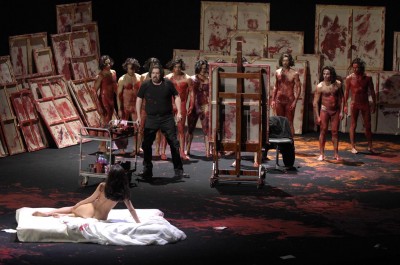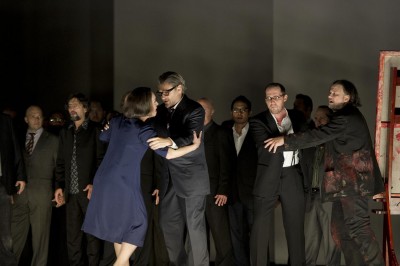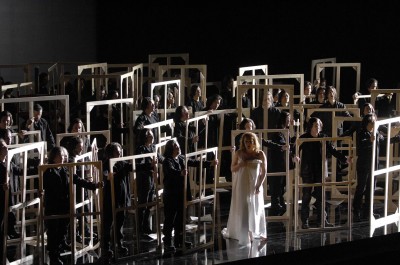Tannhäuser by Robert Carsen at Bastille

Ensemble, credit: Opera National de Paris
Robert Carsen has staged Richard Wagners Tannhäuser in his own way at Opera Bastille. His idea is clean, black, white, black walls, very clean and sober, but, unfortunately in the ened I was feeling it was booring. Only the singers and the choir made the last two acts extraordinary. But the first act with its sensuality, and high temperature between Christopher Ventris as Tannhäuser and Sophie Koch as Venus was splendid. Supplied in the first scene by approximately 20 statists, well choreographed by Philippe Giraudeau, was very good.
Christopher Ventris is a first class Heldentenor as Tannhäuser, and his clear diction is outstanding, without loosing the line of tunes and music, we hear nearly every word, Brilliant. He is so closely followed up by Sophie Koch as Venus so the first scene, which inclusive the ouverture, where we are watching the start of the history 55 minutes long was extraordinary. Then I was afraid when we came to the second scene how they would manage that, but indeed the managed, the septet between the 7 men were continuing the great musically flood, leaded by the great conductor Sir Mark Elder, who has the right musically feeling for it all.

Nina Stemme (Elisabeth), Christof Fischesser (Hermann), Stéphane Degout (Wolfram von Eschenbach) et Christopher Ventris (Tannhäuser). Foto: Elisa Haberer
Together with the scenographer Paul Steinberg, the costumier Constance Hoffman and good lightdesign by Peter van Praet. Robert Carsen has made a staging idea with, as mentioned, the three acts in Black, White and Black, In addition broght the history in to a painter´s atellier- Tannhäuser in his atellier, where he is working painting with red paint his muse, a nude women, Venus, and with his friends, also painters coming roling out of the black sides drawing sketches of Venus, and being so exited that they are running away painting each their painting of the model, that they are bringing on stage of course in many frames – canvases, that we only allways see from the backside, but in these frames is the one symbol going through all the performance, the cross. which is also being repeated when we in the last act get the pilgrim choir on stage, where they all are carrying thes frames without canvases but with the cross holding the frames together. This idea is good and a renewing of the Tannhaüser idea. However, when you in your mind are having the old romantic history of the love affair between Elisabeth, in this performance beautifully performed and sung by Nina Stemme, making her Opera de Paris debut, and Tannhäuser than in the end I am missing the romantic scenes their is no romantic in this performance, only exitement.

Ensemble. Credit: Opera National de Paris.
In the second act, when Elisabeth, Nina Stemme, makes her entre, we have a large gallery rome on stage, with 7 paintings on each their red easel, a continuation from the red paint in the first act, covered by white sheets
. Very talented Elisabeth is entering You Expensive Hall (Dich Teure Halle) through the audience saloon, and singing her famouse entrance aria there, this is OK. She did it well
erectile dysfunction should include a comprehensive sexual,e.g. by walking on viagra.
. Then later, when all the audience for the opening of the exposition of paintings, they too arrive through the audience hall, a good effect, and a good way of using the hall. This is followed by the presentation of the paintings, which are the famouse arias by Wolfram, Stéphane Degout, – beautiful voice, and Biterolf, Tomas Konieczny, brooken up by Tannhäusers annoyed coments, it is being booring with all the choir in normal daily wear, no festivitas. Of course Robert Carsen keeps his style, but Tannhäuser has traditionally so much in it to build a new history. The idea with the painter Tannhäuser is ok. And it starts well. In fact I was missing the twinkle in the eyes that Robert Carsen usually has. We are not here for a funeral!?
The success of this production is, as very often at the Opera de Paris the outstanding good casting: Leaded by the spelendid Christopher Ventris as Tannhäuser, Nina Stemme as Elisabeth, Sophie Koch as Venus, Stéphane Degout as Wolfram, Christof Fischesser as Herman, followed by Stanislas de Barbeyrac, Walther, Tomasz Konieczny, Biterolf, Eric Huchert as Heinrich the writer, and from behind we enjoyed Alix le Saux a capella as the young shepherd. Stéphane Degout´s song to the Evening Star was beautiful, but the ending up laying on the bed on top of Elisabths blue dress was not any elegant, but of course, continued the idea of Robert Carsens idea of the sensuality in his version of Tannhäuser.
Tannhäuser (1845) Grand opéra romantique en trois actes de Richard Wagner (1813-1883)
8 représentations du 6 au 29 octobre 2011 à l’Opéra Bastille
Direction musicale : Sir Mark Elder – Mise en scène : Robert Carsen – Décors : Paul Steinberg – Costumes : Constance Hoffmann – Lumières : Robert Carsen, Peter Van Praet –Chorégraphie : Philippe Giraudeau – Chef du Chœur : Patrick Marie Aubert.
This Tannhäuser was no 393 at the Paris Opera, first time premiered in 1861 in Salle le Peletier, and performance no 14 of this production, who was premiered first time in 2007.
TANNHÄUSER by Stefan Herheim in Oslo:
I dont like to compare to another production in another operahouse. But this time I have to do it. This Tannhäuser production can´t visually compare at all, with the extraordinary Tannhäuser newly prodused (2010) at The Norwegian National Opera made by Stefan Herheim and his outstanding staff lately, where they placed the history in to the halls and surroundings of The Salvation Army in the center of Oslo. That was a good renewing, this is the outstanding way to renew an old classical opera. Please enjoy our review from that production: http://www.kulturkompasset.com/2010/03/fascinerende-tannhauser/
